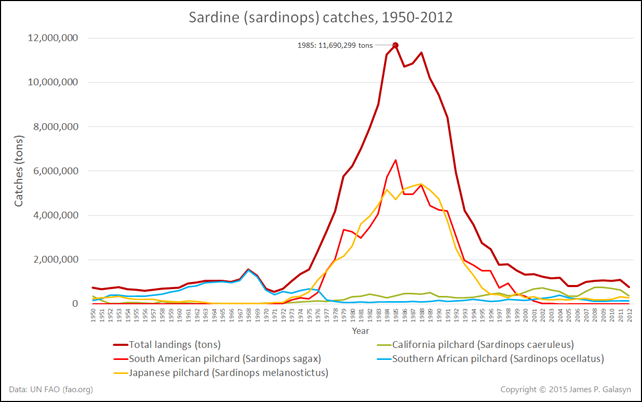Graph of the Day: Sardine (sardinops) depletion, 1950-2012
 22 March 2015 (Desdemona Despair) – You may have noticed the ongoing mass-starvation event among California sea lions. (“Why are California sea lion pups starving?”; “Sick sea lions flood shelters in California – Pups wash ashore all along the coast amid what scientists say are strains on the ocean”) The sea lions are starving because humans have fished out one of their main forage fish, sardines. Desdemona wanted to check the claim that “any fishing on sardines right now is overfishing”, so Des downloaded the latest data from the United Nations Food and Agricultural Organization (FAO). FAO maintains a huge trove of data on world food production, including annual catches of many fish. FAO tracks four sardinops species:
22 March 2015 (Desdemona Despair) – You may have noticed the ongoing mass-starvation event among California sea lions. (“Why are California sea lion pups starving?”; “Sick sea lions flood shelters in California – Pups wash ashore all along the coast amid what scientists say are strains on the ocean”) The sea lions are starving because humans have fished out one of their main forage fish, sardines. Desdemona wanted to check the claim that “any fishing on sardines right now is overfishing”, so Des downloaded the latest data from the United Nations Food and Agricultural Organization (FAO). FAO maintains a huge trove of data on world food production, including annual catches of many fish. FAO tracks four sardinops species:
- California pilchard (Sardinops caeruleus)
- Japanese pilchard (Sardinops melanostictus)
- South American pilchard (Sardinops sagax)
- Southern African pilchard (Sardinops ocellatus)
FAO doesn’t aggregate the data, but it was an easy matter to compute the total catch and graph it. And indeed, it’s clear that as of 2012, sardinops populations worldwide have crashed. The peak catch was in 1985, at 11,690,299 tons, and the annual catch has since plummeted to less than 800,000 tons per year. This is a classic resource depletion curve that follows logistic growth and decline (Hubbert curve). It confirms that the sardinops resource is depleted, and “any fishing on sardines right now is overfishing”. You can get the data and related graphs here: Sardine (sardinops) landings FAO.xlsx.